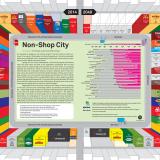Non Shop City
Mark Magazine #54 February/March 2015
Is it possible to imagine a city without shops? If current trends in retail continue, it’s a scenario that seems very likely. Everywhere in the retail-saturated, online shop-obsessed world, the presence of brick-and-mortar stores is waning fast, while digital commerce booms.
Opting for the virtual marketplace, online shops bypass horrendous inner-city retail rents and look to be unbeatably competitive. But are they really poised to replace high-street stores? Or do they dream of occupying physical real estate? An article in The Wall Street Journal (9 October 2014) reported plans by online giant Amazon to open a physical store in New York City, across the street from the Empire State Building. If those plans materialize, Amazon can count among its predecessors Bonobos Inc. (2011), Warby Parker (2013), Birchbox (2014) and BaubleBar (2014): online retailers who have proved that going offline pays off. In the same WSJ article, Bonobos CEO Andy Dunn said that customers who order clothing from Bonobos brick-and-mortar stores spend roughly twice as much as online shoppers.
Regardless of how the trend continues, the impact of online shopping on the city is bound to be increasingly radical. In secondary and tertiary cities – where high-street retailers are already suffering financial losses owing to the ease and range of products offered by online shops – the reality of becoming a non-shop city looms large. And in the world’s primary shopping destinations, the emergence of more and more physical stores operated by online retailers points to added success for the already successful. The shopping street of the future is an ‘event and entertainment boulevard’ filled with merchandise that can be purchased without leaving the comforts of home.
• According to US census data from 2014, online shopping accounts for 6.4% of all retail sales and is set to reach 10% by 2017 (greenbiz.com).
• By 2018 the number of physical stores in the UK will have fallen by 22%, from 281,930 in 2013 to only 220,000
(retailresearch.org).
• In the Netherlands, retail space in urban areas will shrink by 17% over the next seven years, a percentage equal to a reduction of 2 million m2 (analyses by Booz & Company for Het Financieele Dagblad).
Text and graphics: Theo Deutinger, Lucia Usera and Stefanos Filippas
